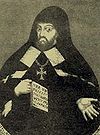
Meletius Smotrytsky
Encyclopedia


Ruthenian language
Ruthenian, or Old Ruthenian , is a term used for the varieties of Eastern Slavonic spoken in the Grand Duchy of Lithuania and later in the East Slavic territories of the Polish–Lithuanian Commonwealth....
(Ukrainian, Belarusian) linguist from Galicia, author and religious activist. Son of the famous Ukrainian religious and political activist Herasym Smotrytsky. He was educated in Ostroh
Ostroh
Ostroh is a historic city located in Rivne Oblast of western Ukraine, located on the Horyn River. Ostroh is the administrative center of the Ostroh Raion and is itself designated as a special administrative subordination within the oblast...
(Ostrog) and Vilnius
Vilnius
Vilnius is the capital of Lithuania, and its largest city, with a population of 560,190 as of 2010. It is the seat of the Vilnius city municipality and of the Vilnius district municipality. It is also the capital of Vilnius County...
, as well as Leipzig
Leipzig
Leipzig Leipzig has always been a trade city, situated during the time of the Holy Roman Empire at the intersection of the Via Regia and Via Imperii, two important trade routes. At one time, Leipzig was one of the major European centres of learning and culture in fields such as music and publishing...
, Wittenberg
Wittenberg
Wittenberg, officially Lutherstadt Wittenberg, is a city in Germany in the Bundesland Saxony-Anhalt, on the river Elbe. It has a population of about 50,000....
and Nuremberg
Nuremberg
Nuremberg[p] is a city in the German state of Bavaria, in the administrative region of Middle Franconia. Situated on the Pegnitz river and the Rhine–Main–Danube Canal, it is located about north of Munich and is Franconia's largest city. The population is 505,664...
. Later, he was rector of Kiev brotherhood's school.
Smotrytsky is best known for his grammar of Church Slavonic (Грамматіки славєнския правилноє Сvнтаґма, 1619), which codified what is now known as "Modern Church Slavonic" or, more specifically, "Meletian Church Slavonic". It was the sole handbook for grammar in Belarusian, Russian and Ukrainian lands, and had an enormous impact on the literary usage in Church Slavonic texts throughout the Slavonic countries. The grammar was reprinted many times.
External links
- Meletij Smotryc'kyj. Grammar, 1619. (Reprint edition, with Ukrainian interface)
- Meletiy Smotritsky, in online Russian Biographical Dictionary (in Russian)
- Meletiy Smotrytsky: a publicist, a scientist and a patriot in Day, 2003, 23 (in Ukrainian).

